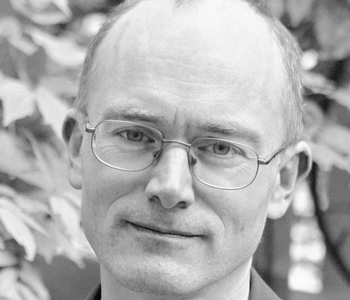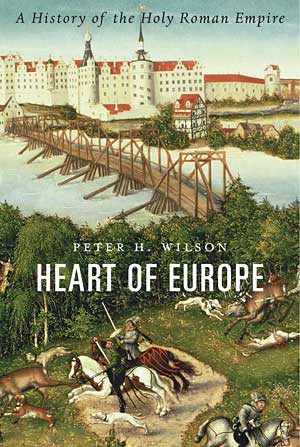
The Holy Roman Empire’s history is central to the European experience and the question of European identity. Founded with Charlemagne’s coronation on Christmas Day 800, it lasted just over a millennium before being dissolved in August 1806 by Emperor Francis II to prevent its legacy being usurped by Napoleon. In addition to what is now Germany, it encompassed at one point or another all or part of Austria, Switzerland, Italy, France, Belgium, Luxembourg, Netherlands, Czech Republic, Denmark, and Poland. Other countries were linked to its history and internal affairs, such as Hungary, Croatia, Spain or Sweden. Europe’s east-west and north-south tensions intersected in the Empire’s core lands between the Alps and the Rhine, Elbe and Oder rivers, while trade, cultural exchange and military campaigns ranged across it in all directions.
Yet, the Empire scarcely figures in most histories of Europe. If it is remembered at all, it is usually through Voltaire’s famous quip that it was ‘neither holy, Roman or an empire’. Voltaire was writing at a time when history was emerging as a professional academic discipline that took the centralised national state as its primary focus. Europe’s history came to be written as a series of discrete national stories, each constructed around homelands, cultures and heroes and heroines credited with forging modern states. Many of these states emerged in direct opposition to the two predominantly German-speaking empires of the nineteenth century: Austria-Hungary and imperial Germany. Nineteenth-century nation-builders in Italy, the Netherlands or elsewhere had no use for the Empire’s history which was reduced to that of medieval Germany. Meanwhile, German writers increasingly regarded it as a source of national shame because it did not develop as the kind of powerful, centralised national monarchy that they believed necessary in their own time.
My book is the first in English to cover the Empire’s entire history and the first in any language to offer a comprehensive reinterpretation of its place in wider European history. It is also the first to dig beneath the surface of high politics and explore how the Empire related to its inhabitants. None of the conventional accounts of the Empire make any sense, because they have tried to reduce its complex story to that of Germany. This is understandable given what we usually associate with the term ‘empire’. We expect empires to emerge through conquest as the people occupying a central ‘core’ territory expand to dominate and exploit those living on the ‘periphery’. This model of empire is deeply rooted in historical writing, not least because of the character of nineteenth and twentieth-century European imperialism. Elements of the Empire’s history indeed fit this model. It was Charlemagne’s success in conquering the Lombards that persuaded Pope Leo III to collaborate with him in establishing the Empire, supposedly as a direct continuation of that of ancient Rome. This, he thought, would offer better protection to the papacy than the real direct successor of imperial Rome, the Byzantine emperor in Constantinople. Similarly, Charlemagne and his immediate successors pushed the Empire’s frontiers eastwards by conquering lands from the heathen Slavs.
However, the Empire never had a stable core territory or a single, permanent capital. Rome remained the preferred location for imperial coronations until 1452, but emperors remained itinerant, moving between their many palaces or free-loading on the abbeys and monasteries they helped to establish and which were obliged to lodge them and their court – not for nothing did one medieval abbot compare an imperial visit with a plague of locusts. The pope retained the exclusive right to crown an emperor until 1508, but the choice of candidate clearly rested with a small group of senior German lords by the mid-tenth century. From 962, whoever was German king was the primary candidate for the imperial title. Yet, the Empire itself was already transpersonal, existing even when no monarch had been crowned emperor. Despite the long-running dispute with the papacy over political precedence, in practice whoever was German king ruled the entire Empire regardless of whether they had been crowned in Rome.
The Empire remains incomprehensible if approached anachronistically from a narrowly political perspective in which a succession of German kings supposedly set out to create a strong national monarchy, only to be distracted by the need to confront recalcitrant popes, or to pursue a seemingly irrelevant imperial mission. That mission forms the subject of the first of the four themes used to structure the book. From the outset, the Empire embodied the ideal of Europe as a single pacific Christian order. The ‘imperial’ element was thus not hegemonic, but rather the monarch’s duty as guardian of the church and upholder of justice. The Empire lacked precise frontiers, because there could be no defined limit to something which was considered universal. The emergence of new ideas of sovereignty around the twelfth century slowly challenged this by suggesting that kings were ‘emperors in their own kingdoms’. Ultimately, national sovereignty became the basis of Europe’s political order, fragmenting the continent into numerous separate states, but the Holy Roman emperor remained formally the senior monarch until the Empire’s dissolution.
The book’s second part examines the mosaic of different lands and peoples comprising the Empire, both in terms of how this changed over time and what these relationships meant for questions of belonging and identity. The Empire never sought the kind of homogeneity desired by later European states which generally compelled their inhabitants to speak the same language and observe a common faith. Though tied by its mission to Christianity, the Empire ultimately avoided becoming tied to any particular form of that religion, and always contained a significant Jewish minority which it protected, though never perfectly, generally better than achieved by other European states. Inhabitants identified with the Empire as the distant, yet overarching guarantor of their own local customs and autonomy.
The third part explains how the Empire was governed, indicating that none of its monarchs attempted to build a centralised state with uniform system of laws or institutions. Instead, the Empire evolved as a multi-layered system largely beyond the emperor’s direct control, but nonetheless subject to his authority. New institutions emerged from the fifteenth century that underpinned this structure by integrating the component territories more clearly into the common legal and political framework. The Empire continued to develop and was able to absorb considerable shocks like the Reformation and the Thirty Years War, but the legal and institutional arrangements became increasingly inflexible during the eighteenth century.
The final section examines how these arrangements were rooted in the Empire’s social order which became defined through corporate rights based on status and place. Many of the institutions created during the fifteenth and sixteenth centuries were intended to resolve tensions between these corporate groups. It became increasingly obvious that underlying demographic, social and economic changes were eroding the formal order by the eighteenth century at least as much as the emergence of Austria and Prussia as European great powers in their own right posed a political challenge to the Empire as a collective of all its constituent territories.
If the casual reader or bookshop-browser were to follow my grandfather’s advice, they would start at the end to see whether my book was worth reading. In this case, they would find my final chapter covering the Empire’s afterlife in European history from the initial horrified reactions to its demise to its place in the current debate over the future of the European Union. Closer inspection of these pages will already suggest why the Empire still matters today, since how it has been interpreted tells us much about wider European history and how the continent’s past has been remembered and interpreted. An alternative starting point might be the numerous maps at the front of the book which show the Empire’s extent and something of its complex internal composition. These maps are a deliberate attempt to correct the impression conveyed by conventional historical atlases which show countries like France or England as solid blocks of colour in contrast to the patchwork quilt that covers central Europe into the mid-nineteenth century. This cartographical convention emerged with the rise of history as a modern profession backed by state funds and charged with writing each nation’s history as a coherent story. Most modern maps still fail to record the full extent of imperial jurisdiction as it existed in the seventeenth and eighteenth centuries, whilst simultaneously obscuring how other European states remained composites of different regions, legal systems, social orders and economic networks until well into the nineteenth century.
Fundamentally, this book shows that no European country has a singular story, no matter what generations of nationalists and populist politicians might have said. All Europe’s countries and peoples are interlinked through historical threads, and these are especially closely woven for those parts of northern, central and southern Europe that once formed the Empire. However, the Empire’s history also indicates that these interrelationships were complex and could be antagonistic. The complexities matter, not only for understanding the stories of what are currently the various European sovereign states, but for how those states currently interact and, indeed, might do in the future through the EU or whatever may replace it. The Empire’s story is primarily one of political culture, of ideal communities and attempts to realise those. A history of purely economic or social relations would no doubt produce a different picture, but one that would equally challenge the dominance of anachronistic national political narratives.
The Empire’s history indeed suggests we should reimagine the European map. Even today, the EU and the continent as a whole are presented as a mosaic of differently-coloured sovereign states, yet the composition of those states differs enormously with central governments and citizens having considerably varying powers and allegiances. Formally, political order remains that defined by the ideal of the sovereign state, yet clearly few states fully-command their inhabitants’ actions or loyalties, nor can they control how external pressures influence their internal affairs. The Empire was characterised by fragmented sovereignty, overlapping jurisdictions, and multiple identities. Reconsidering its history might foster a better appreciation of current transnational and global problems.


Peter H. Wilson is Chichele Professor of the History of War at the University of Oxford and a Fellow of All Souls College. Besides Heart of Europe: A History of the Holy Roman Empire, his books include Europe’s Tragedy: A History of the Thirty Years War, winner of the Society for Military History’s Distinguished Book Award in 2011, and also featured on Rorotoko, as well as a study of the battle of Lützen 1632 and its military, political and cultural legacy which will be published by Oxford University Press in 2017.